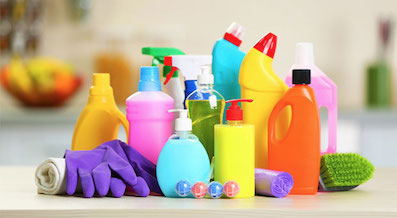 Cleanzine: your weekly cleaning and hygiene industry newsletter 18th April 2024 Issue no. 1110
Cleanzine: your weekly cleaning and hygiene industry newsletter 18th April 2024 Issue no. 1110
Your industry news - first
The original and best - for over 20 years!
We strongly recommend viewing Cleanzine full size in your web browser. Click our masthead above to visit our website version.
How to use cleaning chemicals safely
 By Nisbets, the Avonmouth, Bristol-based catering supplier with branches nationwide
By Nisbets, the Avonmouth, Bristol-based catering supplier with branches nationwide
"Anyone responsible for managing a premises will know how important the cleaning schedule, process and choice of products is. Cleaning products contain chemicals that allow them to do an effective job, but they can be potentially harmful to members of the public and the staff that use them.
There are plenty of things you need to consider to keep everyone safe - and everything clean. We've listed what you need to know below:
* Pictograms, labels and pH scales: To identify the chemicals, you'll need to get to know labels and pictograms effectively. Knowing what the details on the labels mean will also help you to avoid the dangers of incorrectly using the chemicals.
* The labels: Make sure you read the label before you use any cleaning product. Everything should be on the label - as dictated by EU law - including how hazardous the chemicals are, so reading the labels is a very solid place to start.
* Pictograms: Somewhere on the cleaning products, you're likely to find pictograms. Symbols designed to give you crucial information at a glance, pictograms should quickly tell you whether there are hazardous products. You can find a full list of pictograms on the Nisbets website.
* pH scales - the myth:The pH scale rating tells you about the chemical qualities of a product. The range is from 0-14, telling you how acidic (0 = very acidic), neutral (7) or alkaline (14 = very alkaline) a product is. They are displayed on all chemicals, however, they won't indicate whether a product is suitable for your needs, so it's always best to stick to the labels and pictograms.
* PPE: The best way to stay safe when using cleaning chemicals is to ensure you use the right Personal Protective Equipment (PPE) on hand before any work begins. The following are recommended:
(1) Protective eyewear: Especially essential when using chemicals like bleach, protective eyewear is a must-have for protecting one of your most vital of senses. Keep the glasses clean from splashbacks to ensure you have the best vision possible when cleaning.
(2) Gloves: The hands are more exposed to cleaning chemicals than other parts of the body, so you must make sure they are looked after. Whether it's a simple pair of rubber gloves or something more specialist, gloves are the best way to keep corrosive and irritating cleaning products away from your skin.
(3) Protective footwear: Make sure you pop on protective footwear when you are
working with chemicals, which is both waterproof (to stop the chemicals from reaching your feet) and slip-proof (to stop you from falling).
Follow the above points and you should feel informed when picking cleaning chemicals and using them effectively."
T: Tel: 0845 1405555
E: [email protected]
W: www.nisbets.co.uk
5th January 2017







